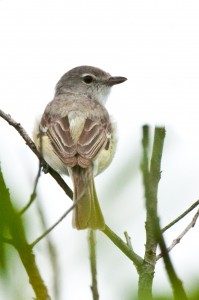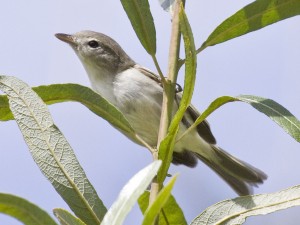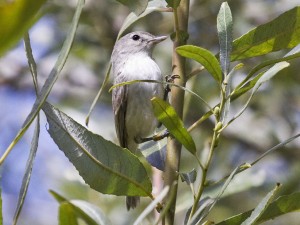Vireo belli pusillus
- Endangered – Endangered Species Act (1986)
- Endangered – California Endangered Species Act (1980)
The least Bell’s vireo is a small, secretive songbird (4-5 inches long) with short, round wings, straight bills, and feathers that are gray above and pale below. Vireos were historically widespread in California’s riparian woodlands and low-elevation riverine valleys, but over 95% of riparian habitat has been lost, accounting for 60 to 80% of the population loss. Breeding populations are now restricted to San Diego, Riverside, and Santa Barbara counties – including the Los Padres National Forest.

Photo by Deepankar Das.
Natural History
The least Bell’s vireo inhabits low-elevation, riparian habitats with a dense shrub understory that is near water. The ideal habitat contains both canopy and shrub layers. They prefer to nest in willows but will also use shrubs, trees, and vines. Most least Bell’s vireos are found below 2,000 feet elevation.
Males begin to establish territories by late March and egg laying usually starts in April. Clutch size (the number of eggs layed) ranges from three to five, and most Californian pairs produce one to two broods per season. The birds are neotropical migrants who leave their breeding range in California to winter in Baja California.
Least Bell’s Vireo in the Los Padres National Forest
While the least Bell’s vireo occurs on all four Southern California national forests, the largest population is found in the Los Padres National Forest, where Mono and Indian creeks meet the Santa Ynez River near Gibraltar Reservoir. This is the only formally-designated critical habitat on National Forest System lands, so it receives special protection under the Endangered Species Act. In 1980, there were 55 breeding pairs, which declined to less than 30 by 1994; in the mid-2000s, the Forest Service reported “less than 12 pairs,” and a recent survey in 2013 did not detect any pairs, suggesting that this population might now be extirpated. Additional surveys are needed to determine whether least Bell’s vireos still breed in this area.

Photo by Bill Bouton.
The least Bell’s vireo is also found in the Santa Clara River watershed in Ventura County. Suitable nesting habitat occurs in Piru Creek and Sespe Creek. There may be suitable habitat in the Santa Maria/Cuyama River watershed as well.
Threats
The least Bell’s vireo’s decline is mainly due to loss and degradation of breeding habitat as well as brood parasitism by brown-headed cowbirds. The shrub cover that the birds require is threatened by roads, overgrazing, concentrated recreation use, fire, and invasive species, according to the U.S. Forest Service. Arundo and tamarisk invasions displace the bird’s native habitat.

Photo by Bill Bouton.
Conservation
The least Bell’s vireo was formally classified as an endangered species in 1986, and its critical habitat was formally designated in 1994. The U.S. Fish & Wildlife Service prepared a draft recovery plan for the vireo in 1998, but that plan was never finalized. Since the bird was listed as endangered, the U.S. population has increased ten-fold from 291 to 2,968 known territories. However, the population in the Los Padres National Forest along the Santa Ynez River has declined 54% since listing.
In the Los Padres National Forest, the easternmost 2.6 miles of Camuesa Road was permanently closed to vehicles and seasonal closures were instigated on Mono Campground in hopes that these efforts will help conserve the least Bell’s vireo.
ForestWatch is working to ensure that riparian areas used by the least Bell’s vireo are protected from development and other activities, hoping to reduce the downward trend of this important northern-most breeding population.






